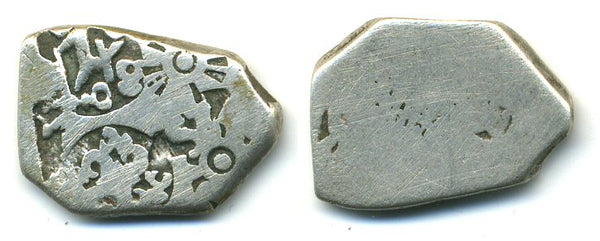
Six different punchmarks on obverse, including a swastika with snake heads on each arm / small banker's marks on reverse. Dates to the later years of Pushyamitra Sunga, probably one of the very last issues of Pushyamitra Sunga ever issued. 18x13mm, 3.2 grams. Hardaker -.The swastika with snake heads on each arm was a characteristic symbol on Sunga bronzes, but seems to be completely unpublished for Sunga silver punchmarks. Very interesting, worthy of further research.The Sunga dynasty was established in 185 BCE, about 50 years after Ashoka's death, when the king Brhadrata, the last of the Mauryan rulers, was brutally murdered by the then commander-in-chief of the Mauryan armed forces, Pusyamitra Sunga, while he was taking the Guard of Honour of his forces. Pusyamitra Sunga then ascended the throne.Pusyamitra Sunga, a Brahmin, is known for his hostility and persecution towards the Buddhist faith. He is recorded as having "destroyed monasteries and killed Monks" (Divyavadana, p429-434): 84.000 Buddhist stupas which had been built by the Mauryan king Ashoka were destroyed (R. Thaper), and 100 gold coins were offered for the head of each Buddhist monk (Indian Historical Quarterly Vol. XXII, p.81 ff cited in Hars.407). A large number of Buddhist monasteries (viharas) were converted to Hindu temples, in such places as Nalanda, Bodhgaya, Sarnath or Mathura.From around 180 BCE the Indian territory was invaded as far as Pataliputra by the Greco-Bactrian ruler Demetrius, with the long-term effect of confining the Sungas to the eastern part of India. Demetrius established an Indo-Greek kingdom in the northern and northwestern part of India, which was to last until the end of the 1st century BCE, and under which Buddhism was able to flourish. In particular, one of the successors of Demetrius, the Indo-Greek "Saviour king" Menander (Pali: Milinda) was a strong benefactor of the Buddhist faith at that time.During the historical Sunga period (185 to 73 BCE), Buddhist activity also managed to survive somewhat in central India (Madhya Pradesh) as suggested by some architectural expansions that were done at the stupas of Sanchi and Bharhut, originally started under King Ashoka. These stupas, however, are located quite far from the Sunga center of power, and it is questioned whether these works were due to the weakness of the control of the Sungas in these areas, or a late sign of tolerance on their part.
